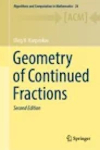- About MAA
- Membership
- MAA Publications
- Periodicals
- Blogs
- MAA Book Series
- MAA Press (an imprint of the AMS)
- MAA Notes
- MAA Reviews
- Mathematical Communication
- Information for Libraries
- Author Resources
- Advertise with MAA
- Meetings
- Competitions
- Programs
- Communities
- MAA Sections
- SIGMAA
- MAA Connect
- Students
- MAA Awards
- Awards Booklets
- Writing Awards
- Teaching Awards
- Service Awards
- Research Awards
- Lecture Awards
- Putnam Competition Individual and Team Winners
- D. E. Shaw Group AMC 8 Awards & Certificates
- Maryam Mirzakhani AMC 10 A Awards & Certificates
- Two Sigma AMC 10 B Awards & Certificates
- Jane Street AMC 12 A Awards & Certificates
- Akamai AMC 12 B Awards & Certificates
- High School Teachers
- News
You are here
Geometry of Continued Fractions

Publisher:
Springer
Publication Date:
2022
Number of Pages:
471
Format:
Hardcover
Edition:
2
Price:
84.99
ISBN:
978-3-662-65276-3
Category:
Monograph
[Reviewed by , on ]
Allen Stenger
10/30/2022
This subject goes back at least to Felix Klein in 1895. His interest was in generalizing continued fractions, and to this end he described a geometric interpretation in terms of convex hulls of the sets of lattice points (points with integer coordinates) in the plane that represent the convergents of the continued fraction. He then sketched how to generalize the geometric representation to higher dimensions. The higher-dimension theory is difficult computationally and languished until about one hundred years later, when computers had become very powerful and the subject was revived by V. I. Arnold.
The geometry used here is not the usual Euclidean geometry, but a special one called integer geometry (or lattice geometry). In the ordinary continued fractions case this is a geometry of lattice points in the plane. We consider only polygons and lines segments whose vertices are lattice points, and the lengths and areas of these are based on counting the number of lattice points they contain. There is also an integer trigonometry, that defines analogs of the plane trigonometry functions in terms of lattice points. This subject takes up about one-fourth of the book and is developed from first principles.
The first half of the book deals with traditional continued fractions and their geometric representation. Most of this is devoted to building up the infrastructure of integer geometry and giving examples of how familiar theorems about continued fractions can be proved using this new framework. In general the geometric proofs are not any easier or clearer than the traditional proofs, so these are mostly for practice and to show that the geometric method is capable of proving them. The second half of the book deals with the generalization to higher dimensions. This subject is still not very highly developed today and the exposition therefore tends to be fragmentary.
I have not seen the first edition of this book (published 2013), but it appears not to be greatly different from this second edition. According to the author’s Preface, the changes are mostly in improvements to the exposition and adding a few omitted items, except that the exposition of Gauss Reduction Theory is reworked and expanded.
The book is largely self-contained, perhaps to a fault: there’s very little information on the history and development of the subject, although some references to historical papers are scattered throughout the book. There are a modest number of exercises at the end of each chapter; most of these are to work out specific numerical examples. I view this as a monograph on a very specialized subject rather than a textbook.
Allen Stenger is a math hobbyist and retired software developer. He was Number Theory Editor of the Missouri Journal of Mathematical Sciences from 2010 through 2021. His personal web site is allenstenger.com. His mathematical interests are number theory and classical analysis.
See the publisher's website.
- Log in to post comments




